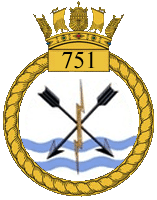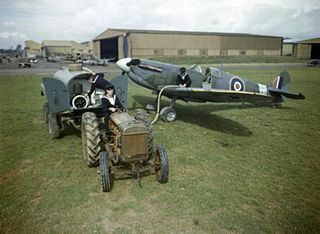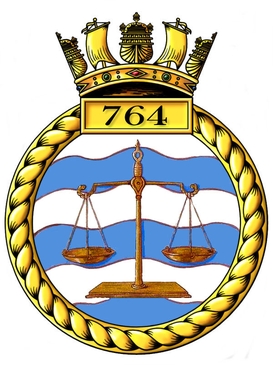
736 Naval Air Squadron was a Naval Air Squadron of the Royal Navy's Fleet Air Arm. It was most recently recommissioned at HMS Seahawk, RNAS Culdrose in June 2013 to fly the BAE Systems Hawk, mainly in the maritime aggressor role, following the disbandment of the Fleet Requirements and Aircraft Direction Unit (FRADU) and operated up until March 2022. It initially formed as the School of Air Combat in May 1943 at HMS Heron, RNAS Yeovilton. In September 1943 it moved to HMS Vulture, RNAS St Merryn, where it became the Fighter Combat School and it created an independent 'B' Flight for fighter affiliation work between March and September 1945. 736 Naval Air Squadron moved to HMS Seahawk, RNAS Culdrose in February 1950 as the Naval Air Fighter School in the 52nd Training Air Group, but disbanded in August 1952. Immediately the following day, the squadron reformed at HMS Seahawk, RNAS Culdrose out of 702 Naval Air Squadron as an Advanced Jet Flying School and in November 1953 it moved to HMS Fulmar, RNAS Lossiemouth. 736 Naval Air Squadron disbanded there in March 1965, but what was left became 764 Naval Air Squadron ‘B’ Flight. The squadron reformed the same day at Lossiemouth from 809 Naval Air Squadron as a Jet Strike Training Squadron. 1966. In March 1967, its aircraft were part of the group that bombed and set on fire the supertanker SS Torrey Canyon aground and leaking crude oil on Seven Sisters rocks off Cornwall. The squadron disbanded in February 1972.

Royal Naval Air Station Dale is a former Royal Naval Air Station, located 10 miles (16 km) South West of Haverfordwest in Pembrokeshire, Wales. It was operational between 1942 and 1948, being used by both the Royal Air Force (1942–1943) and the Royal Navy (1943–1948).

792 Naval Air Squadron was a Naval Air Squadron of the Royal Navy's Fleet Air Arm and was originally formed at RNAS St Merryn in August 1940 as an Air Target Unit, equipped with six Blackburn Skuas. The squadron disbanded in 1945 and merged with 794 Naval Air Squadron. 792 Squadron reformed at RNAS Culdrose in 1948 as a Night Fighter Training Unit. It was initially equipped with Fairey Firefly NF.1s and Avro Ansons. They were later replaced with Sea Hornets shortly before the squadron disbanded again in August 1950.

778 Naval Air Squadron was a Naval Air Squadron of the Royal Navy's Fleet Air Arm. During the Second World War the squadron was a Service Trials Unit (STU) initially based at HMS Daedalus, RNAS Lee-on-Solent, Hampshire, England before moving to HMS Condor, RNAS Arbroath, Angus, Scotland on 6 July 1940. The squadron tested all types of aircraft that could be used by the Royal Navy. Key to this was testing new types for deck landing on aircraft carriers. Such aircraft included various types of Supermarine Seafires, Grumman Hellcats, Grumman Martlets, Grumman Avengers, and Vought Corsairs. The squadron was reformed on 5 November 1951 with Douglas Skyraider AEW.1 but was disbanded on 7 July 1952 to form the basis of 849 Naval Air Squadron.

748 Naval Air Squadron was a Naval Air Squadron of the Royal Navy's Fleet Air Arm. It was initially formed, at HMS Vulture, RNAS St Merryn, as a Fighter Pool Squadron, before becoming No. 10 Naval Operational Training Unit. The squadron moved to HMS Dipper, RNAS Henstridge, in February 1944 and then onto HMS Heron, RNAS Yeovilton in the March. In September 1944, 748 Naval Air Squadron moved to HMS Goldcrest, RNAS Dale, in Wales, remaining for just under twelve months, before moving back to HMS Vulture, RNAS St Merryn in August 1945, where it disbanded in February 1946. During its existence, the squadron was equipped with numerous aircraft and various marks, operated by the Fleet Air Arm.

751 Naval Air Squadron was a Naval Air Squadron of the Royal Navy's Fleet Air Arm. It was initially active as an Observer Training Squadron from 1939 to 1944 as part of No.1 Observer School. 751 Naval Air Squadron formed at RNAS Ford in May 1939. Ford was attacked and bombed, in August 1940, and the following day the squadron relocated to RNAS Arbroath. Twelve months later it moved to RNAS Dundee, remaining there until disbanding at Dundee in May 1944.

758 Naval Air Squadron was a Naval Air Squadron of the Royal Navy's Fleet Air Arm. It was initially formed as a Telegraphist Air Gunner Training Squadron, from 1939 and 1941, renumbered from 759 Naval Air Squadron, operating out of RNAS Eastleigh. It moved to RNAS Arbroath, in 1940, disbanding there the following year. The squadron reformed at RNAS Donibristle, in 1942, as a Beam Approach School. Moving to RNAS Hinstock, it was known as the Naval Advanced Instrument Flying School. It provided instrument courses, utilising a large number of Oxford aircraft, with detachments sent to the specialised flying schools at RNAS Crail, RNAS East Haven, RNAS Fearn and RNAS Yeovilton. 'X' and 'Y' Rover Flights supplemented the detachments, 'Z' Flight was on calibration work and evolving homing and landing capabilities, with the squadron disbanding in 1946, at RNAS Peplow, into 780 Naval Air Squadron.

759 Naval Air Squadron was a Naval Air Squadron of the Royal Navy's Fleet Air Arm. It was created on November 1, 1939, and was disbanded on December 24, 1969. It was initially intended as a Telegraphist Air Gunner Training Squadron but became a Fighter School and Pool Squadron in 1939, at RNAS Eastleigh. It operated out of RNAS Yeovilton from 1940 to 1946, as part of the Naval Air Fighter School. In 1943 a detachment operated out of RNAS Angle, working with 794 NAS and known as the Naval Air Firing Unit. It was again the Naval Air Fighter School upon reformation in 1951 and disbandment in 1954, firstly at RNAS Culdrose and then moving to RNAS Lossiemouth, in 1953. The squadron reformed again, this time at RNAS Brawdy in 1963, as the Naval Advanced Flying Training School, before finally disbanding in 1969.

761 Naval Air Squadron was a Naval Air Squadron of the Royal Navy's Fleet Air Arm. It was formed at HMS Heron, RNAS Yeovilton, as the Advanced Training Squadron of the Fleet Fighter School, in 1941. The squadron moved to HMS Dipper, RNAS Henstridge, in 1943, as part of the No. 2 Naval Air Fighter School. It remained at HMS Dipper and in this role, until January 1946, when the squadron disbanded.

764 Naval Air Squadron was a Naval Air Squadron of the Royal Navy's Fleet Air Arm. It initially formed in April 1940, at HMS Daedalus, RNAS Lee-on-Solent, as an Advance Seaplane Training Squadron. The Squadron moved to RAF Pembroke Dock in July 1940, and later to HMS Daedalus II, RNAS Lawrenny Ferry in October 1941 and remaining there until the Squadron disbanded in November 1943. It reformed at HMS Siskin, RNAS Gosport, in February 1944, as the User Trials Unit, however, the squadron was decommissioned for the second time in September 1945. 764 Naval Air Squadron reformed again, at HMS Fulmar, RNAS Lossiemouth, in May 1953, where it became an Advanced Training Unit. It moved to HMS Heron, RNAS Yeovilton, in September 1953, where it received its first jet aircraft. In November 1954 the Squadron disbanded.

765 Naval Air Squadron was a Naval Air Squadron of the Royal Navy's Fleet Air Arm. It formed at RNAS Lee-on-Solent, in May 1939, as a Seaplane School and Pool squadron. The squadron moved to RNAS Sandbanks, in August 1940, where it undertook the Seaplane Flying Training Course Part I. Lieutenant Commander J.B. Wilson was appointed as dual officer in charge of the air base, and Commanding officer of 765 NAS. By the middle of 1943, dedicated Seaplane Training schools ended and the squadron disbanded in the October. 765 NAS reformed at RNAS Charlton Horethorne, in early February 1944, as a Travelling Recording Unit. The squadron moved to RNAS Lee-on-Solent in March, before moving to RNAS Worthy Down on one month later during April, then in May it moved to RNAS Stretton, were it remained during June.

766 Naval Air Squadron was a Naval Air Squadron of the Royal Navy's Fleet Air Arm. It was to have initially formed in 1939 at HMS Daedalus, RNAS Lee-on-Solent, as a Seaplane School, however, it formed at HMS Landrail, RNAS Machrihannish, as a Night ALT Course, in 1942. It moved to HMS Nightjar, RNAS Inskip, in 1943, to become part of No. 1 Naval Operational Training Unit. By 1944, it was operating over 30 Swordfish aircraft, but, during the year, also acquired Firefly aircraft from 1772 NAS, and Sea Hurricane aircraft from 760 NAS. It moved to HMS Merganser, RNAS Rattray, early in 1946, but later that year, moved to HMS Fulmar, RNAS Lossiemouth, where it received Seafire aircraft, along with being Part 1 of the Operational Flying School. By late 1951, Sea Fury trainer aircraft were also added to its varied list of types operated. In 1953, the squadron moved to HMS Seahawk, RNAS Culdrose, where it disbanded in 1954.

767 Naval Air Squadron was a Naval Air Squadron of the Royal Navy's Fleet Air Arm. It was initially formed as a Deck Landing Training Squadron in 1939, when 811 Naval Air Squadron was renumbered 767 Naval Air Squadron, at HMS Merlin, RNAS Donibristle. A detachment went to Hyeres de la Palyvestre in the south of France, enabling training in fairer conditions. While here, the squadron took on an operational mission, with a bombing attack on the Italian port of Genoa. With the fall of France the squadron evacuated to French Algeria, where it split. Part went to Malta, forming 830 Naval Air Squadron, the other part to HMS Ark Royal, with personnel returning to the UK via Gibraltar. The squadron regrouped at HMS Condor, RNAS Arbroath, and moved to the Deck Landing School at HMS Peewit at RNAS East Haven in 1943.

777 Naval Air Squadron was a Naval Air Squadron of the Royal Navy's Fleet Air Arm, which formed as a Fleet Requirements Unit in West Africa during the Second World War. Throughout most of 1943, the squadron was responsible for the air defence of Sierra Leone. It disbanded at HMS Spurwing, RNAS Hastings, Sierra Leone, during December 1944. The squadron reformed in May 1945, from 'B' Flight of 778 Naval Air Squadron, as a Carrier Trials Unit operating aboard HMS Pretoria Castle, and using shore bases at HMS Siskin, RNAS Gosport, and HMS Peregrine, RNAS Ford in England, and HMS Wagtail, RNAS Ayr, in Scotland. 777 Naval Air Squadron number was assigned to the aircraft collection at the Fleet Air Arm Museum in April 2006.

780 Naval Air Squadron was a Naval Air Squadron of the Royal Navy's Fleet Air Arm which last disbanded at HMS Seahawk, RNAS Culdrose in November 1949. 780 Naval Air Squadron formed at HMS Raven, RNAS Eastleigh as a Conversion Course Unit, in October 1939, to train experienced civilian pilots in naval flying. It moved to HMS Daedalus, RNAS Lee-on-Solent, in October 1940, and later, its role had changed to converting pilots to Fairey Barracuda aircraft. It spent a year at RNAS Charlton Horethorne, before returning to HMS Daedalus and disbanded, early 1945. In March 1946, the squadron reformed at HMS Godwit, RNAS Hinstock, as the Naval Advanced Flying School, to give flying instructors' courses, and later provided Instrument Flying Training. In December, the squadron moved to HMS Jackdaw, RNAS Crail, then in March 1947 moved to HMS Merlin, RNAS Donibristle, and in May to HMS Seahawk as the first resident unit.

787 Naval Air Squadron was a Naval Air Squadron of the Royal Navy's Fleet Air Arm which disbanded in January 1956. It formed in March 1941, at HMS Heron, RNAS Yeovilton, out of 804 Naval Air Squadron as a Fleet Fighter Development Unit. Almost every type of fighter was received by the squadron for testing and evaluation for naval use. A move to RAF Duxford in June 1941 saw it become the Naval Air Fighting Development Unit, attached to the Royal Air Force's Air Fighting Development Unit. The squadron undertook rocket projectile test, continuous development of fighter tactics and even helping Torpedo Bomber Reconnaissance squadrons in evading fighter attack. Post Second World War it continued its trials task and also undertook Rebecca radar trials and ASH, US-built air-to-surface-vessel radar trials.

790 Naval Air Squadron was a Naval Air Squadron of the Royal Navy's Fleet Air Arm which disbanded in November 1949 at RNAS Culdrose. It initially formed during 1941 as an Air Target Towing Unit, at HMS Landrail, RNAS Macrihanish, in Scotland, from elements of two other Fleet Air Arm squadrons, however, this only lasted for three months and the unit was disbanded, absorbed into 772 Naval Air Squadron. It reformed the following year, in July 1942, tasked as a Fighter Direction Training Unit, at RNAS Charlton Horethorne. It provided support for the Fighter Direction School and had short spells at RAF Culmhead and RNAS Zeals, before reloacting to RNAS Dale in Pembrokeshire, next to the new purpose built Air Direction School, HMS Harrier or RNADC Kete, in 1945. The squadron moved to HMS Seahawk in Cornwall during December 1947.

794 Naval Air Squadron was a Naval Air Squadron of the Royal Navy's Fleet Air Arm which disbanded in March 1947. The squadron formed as an Air Target Towing Squadron, at HMS Heron, RNAS Yeovilton, during August 1940, although operated target tug aircraft out of the satellite, RNAS Haldon. In April 1943 it provided a detachment at RAF Warmwell as an air firing unit and three months later the squadron relocated to RNAS Angle and became the Naval Air Firing Unit. Further moves followed in quick succession, to HMS Goldcrest, RNAS Dale, in September, HMS Dipper, RNAS Henstridge, in November and HMS Heron II, RNAS Charlton Horethorne in December and by which time the squadron was designated No. 1 Naval Air Firing Unit, but disbanded in June 1944. The squadron reformed at HMS Vulture, RNAS St Merryn, in January 1945, as the School of Air Firing and later in the year was tasked to support the newly formed Ground Attack School. It moved to HMS Gannet, RNAS Eglinton, during August, and at this point had three flights providing courses for aerial warfare, airstrike and aerial reconnaissance.

796 Naval Air Squadron was a Naval Air Squadron of the Royal Navy's Fleet Air Arm which last disbanded at RNAS Culdrose in October 1958. 796 Naval Air Squadron formed as the Eastern Fleet Torpedo Bomber Reconnaissance Pool, at RN Air Section Port Reitz, in Mombasa, in July 1942, it provided a detachment embarked in HMS Illustrious in August to support the invasion of Madagascar. This Flight also disembarked to Majunga in September to join 207 Group of the Royal Air Force and later rejoined the squadron at RNAS Tanga, in November and added operational training unit to its roles until disbanding in April 1944. It reformed in November 1947 at HMS Vulture, RNAS St Merryn, as the Aircrewman Training School, for conversion of T.A.G.'s to aircrewman standard. Its task changed to Observer School Part II in January 1950. The squadron moved to HMS Seahawk, RNAS Culdrose, in November 1953 and in 1957 took on the task of the disbanded 765 Naval Air Squadron.

798 Naval Air Squadron was a Naval Air Squadron of the Royal Navy's Fleet Air Arm which disbanded in March 1946. It formed at RNAS Lee-on-Solent, in October 1943, to provide advanced conversion courses, it initially operated with various single and twin-engined aircraft. Twin-engined aircraft broke away to become 762 Naval Air Squadron during March 1944. It had a detachment at RNAS Stretton for operational training for new Fairey Barracuda squadrons, but returned to HMS Daedalus at the beginning of August. The unit’s role changed slightly during 1945, providing refresher training, including Fleet Air Arm ex-Prisoners of War at RNAS Halesworth. The squadron moved to RNAS Hinstock, although operated out of its satellite RNAS Peplow, during November 1945.





















